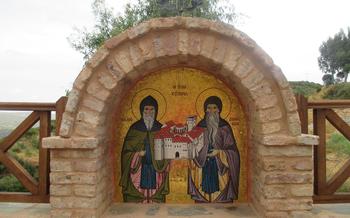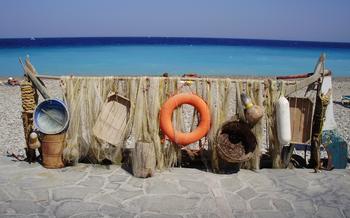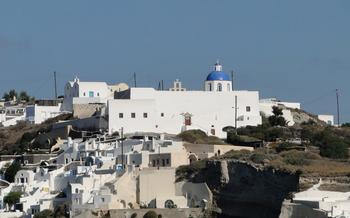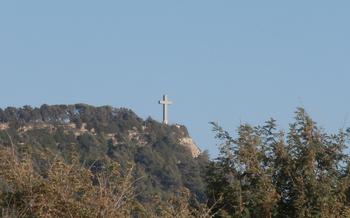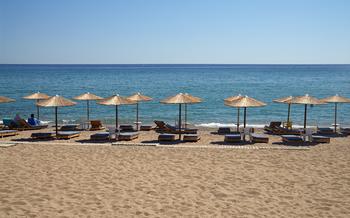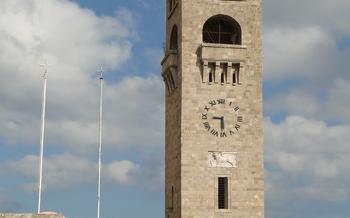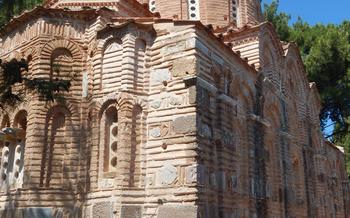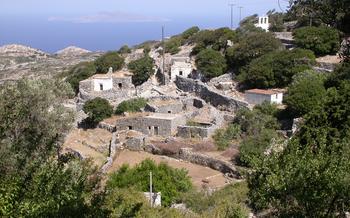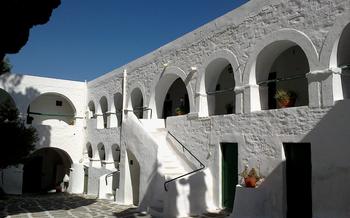
Monastery of Tsambika
- Historical Significance
- Panoramic Views
- Pilgrimage Traditions
- Tsambika Beach: A Paradise Awaits
- Hiking Trails
- Festivals and Events
- Local Cuisine
- Photography Opportunities
- Cultural Significance
- Accessibility
- Accommodation Options
- Guided Tours
- Appropriate Attire
- Insider Tip: Unveiling the Hidden Charm of the Monastery
Historical Significance
The Monastery of Tsambika holds immense historical and religious significance in the region. Founded in the 11th century, it is dedicated to the Virgin Mary, known as Panagia Tsambika, and is considered one of the most important pilgrimage sites in Greece. The monastery's origins are shrouded in legend, with stories of miraculous interventions by the Virgin Mary leading to its establishment. Over the centuries, it has undergone renovations and expansions, reflecting the devotion and patronage of the faithful. Its unique architecture, blending Byzantine and Venetian styles, showcases the rich artistic heritage of the region. The monastery's collection of religious artifacts, including icons, manuscripts, and relics, further adds to its historical and cultural value.
Panoramic Views
The Monastery of Tsambika offers breathtaking panoramic views that will leave you mesmerized. Perched atop a hill, the monastery provides a sweeping vista of the surrounding landscape. As you stand on the monastery's terrace, your eyes will be drawn to the azure waters of the Aegean Sea, sparkling in the sunlight. The picturesque Tsambika Beach, with its golden sands and crystal-clear waters, stretches out before you, inviting you to take a refreshing dip. In the distance, you can catch glimpses of nearby islands, their rugged coastlines adding a touch of drama to the scenery.
To capture the best panoramic shots, head to the monastery's viewing platform. This elevated spot offers unobstructed views of the surrounding area. Bring your camera and tripod to capture stunning photos of the monastery against the backdrop of the sea and sky. For a truly unforgettable experience, visit the monastery at sunrise or sunset, when the warm golden light casts a magical glow on the landscape.
Pilgrimage Traditions
The Monastery of Tsambika holds a significant place in the hearts of Orthodox Christian pilgrims. Each year, during the feast of the Virgin Mary on September 8th, thousands of pilgrims flock to the monastery to pay homage and seek blessings. The annual pilgrimage is a deeply rooted tradition, attracting believers from near and far.
During the pilgrimage, the monastery transforms into a vibrant hub of religious fervor. Pilgrims arrive with offerings, light candles, and pray at the icon of the Virgin Mary, believed to possess miraculous powers. The atmosphere is filled with devotion, chanting, and the sweet aroma of incense.
Pilgrims often engage in various rituals and customs during their visit. Some crawl on their knees up the long staircase leading to the monastery as a sign of penance and devotion. Others tie ribbons or scarves to the trees and shrubs surrounding the monastery, symbolizing their wishes and prayers.
Stories and anecdotes abound about the miraculous interventions of the Virgin Mary. Pilgrims share tales of healing, answered prayers, and divine guidance experienced at the monastery. These stories reinforce the deep faith and devotion that draw pilgrims to the Monastery of Tsambika year after year.
Tsambika Beach: A Paradise Awaits
Nestled at the foot of the majestic Monastery of Tsambika, Tsambika Beach beckons with its pristine beauty and tranquil ambiance. Immerse yourself in the crystal-clear waters, shimmering in shades of turquoise and sapphire. Feel the soft, golden sands caress your feet as you stroll along the idyllic shore. Surrounded by breathtaking scenery, Tsambika Beach offers a sanctuary for relaxation and rejuvenation.
Indulge in a refreshing swim, bask in the warm Mediterranean sun, or simply unwind on the sunbeds, letting the gentle sea breeze lull you into a state of serenity. For the adventurous souls, water sports enthusiasts can partake in thrilling activities such as jet skiing, windsurfing, and parasailing, adding an element of exhilaration to your beach day.
After a day of sun-kissed adventures, savor the delectable offerings of the tavernas and restaurants that line the beachfront. Relish the flavors of traditional Greek cuisine, savoring the freshest seafood delicacies and indulging in mouthwatering local specialties. As the sun begins its descent, the sky transforms into a canvas of vibrant hues, casting a magical glow upon the beach.
Plan your beach day strategically by packing essentials such as sunscreen, a hat, and comfortable beachwear. Remember to bring along a camera to capture the captivating beauty of this natural paradise. For those seeking a secluded haven, venture further along the coast to discover hidden coves and secluded spots, where you can immerse yourself in the tranquil embrace of nature.
Whether you seek relaxation, adventure, or a culinary journey, Tsambika Beach offers an unforgettable experience, leaving an indelible mark on your Rhodes adventure. Embrace the tranquility, revel in the beauty, and create memories that will last a lifetime.
Hiking Trails
The Monastery of Tsambika is nestled amidst the picturesque hills of Rhodes, offering a unique opportunity for hikers to explore the surrounding natural beauty. Several hiking trails of varying difficulty levels lead to the monastery, providing breathtaking views and encounters with the local flora and fauna.
The most popular trail begins at the village of Tsambika and ascends through a lush pine forest. The path is well-marked and offers stunning vistas of the Aegean Sea and the surrounding countryside. Along the way, hikers can admire the diverse plant life, including fragrant wild thyme and colorful wildflowers.
For a more challenging hike, experienced hikers can embark on the trail from the village of Archangelos. This route takes you through a rugged terrain with steep inclines and rocky outcrops. The reward for the effort is the panoramic view from the summit, where hikers can witness the monastery perched on a hilltop, overlooking the azure waters of the Aegean Sea.
Hikers are advised to wear comfortable shoes, bring plenty of water, and start early in the morning to avoid the midday heat. The trails are generally safe, but it's essential to be mindful of loose rocks and uneven terrain.
Whether you're a seasoned hiker or a nature enthusiast, the hiking trails to the Monastery of Tsambika offer a rewarding experience, combining physical activity, stunning scenery, and a touch of spirituality.
Festivals and Events
The Monastery of Tsambika is not only a place of pilgrimage and religious devotion but also a vibrant hub for cultural and community events. Throughout the year, the monastery plays host to a variety of festivals and celebrations that showcase the rich traditions and heritage of the region.
One of the most significant events is the annual feast of the Virgin Mary, celebrated on September 8th. This joyous occasion attracts thousands of pilgrims and visitors who flock to the monastery to pay homage to the Virgin Mary, the patron saint of Tsambika. The festivities include elaborate processions, traditional music and dance performances, and a festive atmosphere that fills the air.
In addition to religious festivals, the monastery also hosts cultural events such as art exhibitions, concerts, and theatrical performances. These events provide a platform for local artists and performers to showcase their talents and share their cultural heritage with the community.
For those seeking a truly immersive experience, attending one of the festivals or events at the Monastery of Tsambika is a must. It's an opportunity to witness the vibrant spirit of the region, connect with the local community, and create lasting memories in this sacred and enchanting place.
To find out more about upcoming festivals and events, visitors can check the monastery's official website or inquire with the local tourist information center.
Local Cuisine
The Monastery of Tsambika is surrounded by a culinary haven, tantalizing the taste buds of visitors with authentic Greek cuisine. Immerse yourself in the flavors of traditional dishes, such as moussaka, a delectable eggplant and ground meat casserole, or souvlaki, succulent grilled skewers of meat. Savor the freshness of seafood specialties, showcasing the bounty of the Aegean Sea.
Discover tavernas and restaurants nestled amidst charming cobblestone streets, where the aromas of herbs and spices waft through the air. Indulge in the warmth of Greek hospitality as you relish the flavors of homemade dishes, prepared with love and passed down through generations.
For a truly unforgettable culinary experience, try the local honey, produced by bees that feed on the nectar of wildflowers that bloom on the hillsides surrounding the monastery. Its unique flavor and aroma will transport you to a world of sweetness.
Whether you prefer a hearty meal or a light snack, the area around the Monastery of Tsambika offers a culinary journey that will leave you wanting more. Embrace the flavors of Greece and savor the memories of your gastronomic adventure.
Photography Opportunities
The Monastery of Tsambika presents a treasure trove of photography opportunities for enthusiasts of all skill levels. The picturesque architecture, with its whitewashed walls, arched doorways, and intricate carvings, provides a stunning backdrop for capturing timeless shots. The panoramic views from the monastery's elevated position offer breathtaking compositions that encompass the azure waters of the Aegean Sea, the golden sands of Tsambika Beach, and the verdant landscapes of the surrounding countryside.
Inside the monastery, the exquisite religious iconography provides a subject matter rich in symbolism and artistic merit. The beautifully preserved frescoes, mosaics, and paintings depict biblical scenes and figures with vibrant colors and intricate details, offering a glimpse into the monastery's rich history and spiritual significance.
The play of light and shadow throughout the day creates dynamic and ever-changing compositions. The soft, golden light of sunrise and sunset casts a warm glow on the monastery's exterior, while the midday sun accentuates the architectural details and panoramic vistas. For capturing the most dramatic shots, consider visiting during these times.
To make the most of your photography experience, bring a camera with a wide-angle lens to capture the expansive views and a telephoto lens for close-ups of the intricate details. A tripod will help stabilize your camera for sharp and steady shots, especially in low-light conditions. Remember to be respectful of the religious significance of the site and avoid using flash photography inside the monastery.
Whether you're a seasoned photographer or simply enjoy capturing beautiful moments, the Monastery of Tsambika offers an abundance of opportunities to create stunning images that will serve as lasting mementos of your visit to this sacred and picturesque destination.
Cultural Significance
The Monastery of Tsambika holds immense cultural significance in the region of Rhodes. It serves as a symbol of Greek Orthodox tradition and heritage, deeply embedded in the local way of life. The monastery has played a crucial role in preserving and promoting Greek Orthodox customs, beliefs, and festivals. Over the centuries, it has fostered a sense of community and unity among the local population. The annual pilgrimage during the feast of the Virgin Mary is a testament to the cultural and spiritual importance of the monastery, attracting thousands of faithful from across the island and beyond. The monastery's influence extends beyond religious practices, shaping local customs, traditions, and celebrations. It has become an integral part of the cultural fabric of Rhodes, contributing to the island's unique identity and rich heritage.
Accessibility
Reaching the Monastery of Tsambika involves a scenic journey through the picturesque landscapes of Rhodes. Multiple transportation options make it accessible to travelers from various locations. Public buses provide regular service from Rhodes Town and surrounding areas, ensuring a convenient and affordable mode of transport. Taxis are readily available for those seeking a more direct and personalized journey. For those who prefer the freedom of exploration, rental cars offer the flexibility to customize their itinerary and discover the island's hidden gems at their own pace.
Upon arrival at the monastery, ample parking facilities are available for visitors' convenience, ensuring a hassle-free experience. The monastery's commitment to inclusivity extends to providing accessibility for visitors with disabilities. Designated parking spaces, wheelchair-accessible ramps, and well-maintained pathways make it possible for everyone to enjoy the monastery's spiritual and cultural treasures.
To ensure a smooth and enjoyable journey, it is advisable to plan ahead and choose the transportation option that best suits your needs and preferences. Whether you opt for the convenience of public transport, the comfort of a taxi, or the freedom of a rental car, the Monastery of Tsambika welcomes you with open arms.
Accommodation Options
After a fulfilling visit to the Monastery of Tsambika, consider extending your stay in this picturesque region by exploring the diverse accommodation options nearby. From charming hotels nestled amidst olive groves to cozy guesthouses offering traditional Greek hospitality, there's something to suit every traveler's preference and budget.
For those seeking a luxurious and tranquil retreat, the five-star Tsambika Beach Resort offers breathtaking sea views, private balconies, and an array of amenities, including a spa, fitness center, and multiple dining options. For a more intimate experience, the family-run Villa Maria offers cozy rooms with stunning garden views, just a short stroll from the monastery.
Budget-conscious travelers will find a range of affordable options, such as the Tsambika Studios, which offers basic yet comfortable accommodations with kitchenettes for self-catering. For those seeking a unique and local experience, consider staying at one of the traditional Greek guesthouses, where you can immerse yourself in the warmth and hospitality of the local community.
No matter your choice of accommodation, you'll find yourself ideally situated to explore the monastery and its surroundings. Whether you prefer to relax on the golden sands of Tsambika Beach, embark on scenic hiking trails, or delve deeper into the region's rich history and culture, the area offers an abundance of experiences to create lasting memories.
Guided Tours
Enrich your visit to the Monastery of Tsambika by embarking on a guided tour. Led by knowledgeable and experienced guides, these tours offer an immersive experience that delves into the rich history, religious significance, and architectural wonders of the monastery.
Explore the hidden corners and secret chambers of the monastery as your guide unveils the fascinating stories and legends that have shaped its existence. Gain insights into the lives of the monks and pilgrims who have graced these sacred grounds throughout the centuries.
Choose from a variety of tour options to suit your interests and preferences. Group tours provide a social and interactive experience, allowing you to share your questions and observations with fellow travelers. Private tours offer a more personalized and intimate exploration, tailored to your specific interests and pace. Thematic tours focus on specific aspects of the monastery, such as its architecture, religious iconography, or pilgrimage traditions.
Booking a guided tour in advance is recommended, especially during peak tourist season, to secure your spot and avoid disappointment. Check with local tour operators or the monastery's official website for tour availability and pricing information.
Whether you are a history buff, a religious pilgrim, or simply seeking a deeper understanding of Greek culture, a guided tour of the Monastery of Tsambika is an experience not to be missed.
Appropriate Attire
When visiting the Monastery of Tsambika, it is essential to dress respectfully, as it is an active place of worship. While the monastery welcomes visitors of all faiths and backgrounds, it is important to be mindful of the religious significance of the site and to dress accordingly.
For women, it is recommended to wear a long skirt or dress that covers the knees, as well as a top that covers the shoulders. Shorts, tank tops, and revealing clothing are not appropriate. Men should also dress modestly, avoiding shorts and tank tops. It is also customary to remove hats and sunglasses when entering the monastery church.
By dressing appropriately, visitors can show respect for the religious traditions of the monastery and ensure a comfortable and enjoyable visit for all. A personal anecdote highlights the importance of appropriate attire: During my visit, I noticed a group of tourists who were turned away from entering the monastery due to their revealing clothing. It was a reminder that while the monastery is open to visitors, it is essential to respect the religious customs and traditions of the site.
Insider Tip: Unveiling the Hidden Charm of the Monastery
Beyond the main attractions of the Monastery of Tsambika, there lies a hidden gem waiting to be discovered. As you wander through the monastery grounds, take a moment to seek out the secluded courtyard garden. This tranquil oasis, tucked away from the crowds, offers a serene escape amidst the monastery's grandeur. Adorned with vibrant flowers, fragrant herbs, and ancient olive trees, the garden exudes a sense of peace and tranquility. Find a secluded bench, immerse yourself in the beauty of nature, and let the serenity of the surroundings wash away your worries. This hidden gem is the perfect spot to pause, reflect, and truly connect with the spiritual essence of the monastery.

